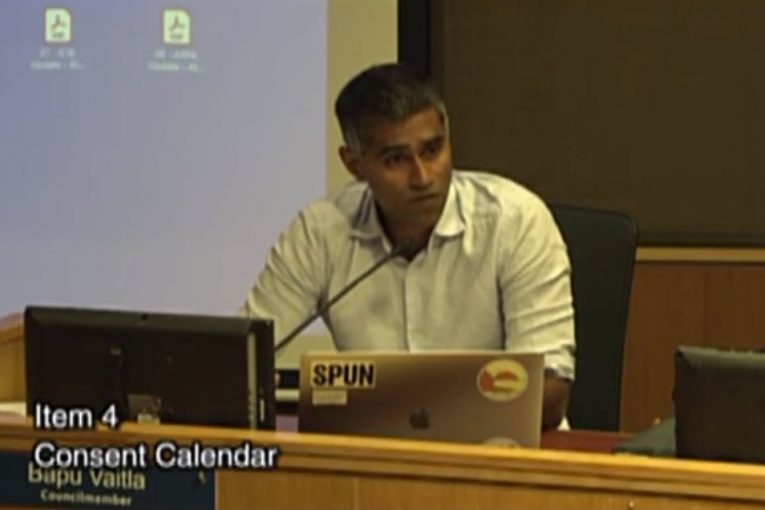

By David M. Greenwald
Executive Editor
Davis, CA – Councilmember Bapu Vaitla pulled the consent item on the EIR Contract for Village Farms to discuss additional evaluations of a more dense alternative.
Councilmember Vaitla noted that there are seven alternative project alternative scenarios that are considered eventually in the scope of services. And all of those alternative scenarios will be examined qualitatively.
While recognizing that an equal analysis of all alternatives is very expensive, Vaitla said, “So I’d like to request that perhaps we can look at less alternatives, but at least a couple of those in a more detailed fashion.”
“If I understand it correctly, you’re suggesting that perhaps in lieu of doing seven alternatives at a qualitative level, that there might be a couple fewer alternatives evaluated, but with some more data and more information to accompany them,” City Manager Mike Webb responded.
“It’s definitely something that we can do,” City Attorney Inder Khalsa responded. “I do see doing a deeper job on perhaps one or two alternatives, maybe more cost effective than attempting to do that on all of the alternatives.”
She added that, generally under CEQA, “we choose alternatives because they reduce environmental impacts. And so it is very common to see alternatives that are a reduced scope of the same project.”
Sherri Metzger, the City’s Community Development Director, noted that the one area that might generate the need for additional analysis is the traffic study, but she noted that’s “already about half the budget.”
She added, “The primary purpose for doing alternatives is to reduce the impacts. So that may mean you have a less dense project than what we already have. It may mean a something different kind of project than what you’re currently contemplating.”
But Vaitla had the opposite in mind.
“What I had in mind is a higher density project, make sure that that project alternative is explored fully,” he said.
He hopes that the CEQA “analysis is refined enough to capture… is a higher density project should lead to, let’s say, less space that are required to meet housing targets.”
For example, he wants to see more open space preservation and improved VMT per capita.
Councilmember Donna Neville suggested that “the sort of prime opportunity for us to make those refinements is at the notice of preparation stage as we consider the project’s scope.”
Metzger responded, “If you want the proposed project to have that analysis, then absolutely. If you’re looking at it as one of the alternatives, I’ve never had it done at the NOP stage, but that doesn’t mean it couldn’t be brought up then.”
Mike Webb added that “the scoping period is the time at which the city is seeking community feedback, identifying the alternatives that are planned to be evaluated in the EIR, that 30-day scoping period, which the NOP, the notice of preparation initiates the scoping period, and that’s the time at which the alternatives get refined. There’s community input during that scoping period.”
Webb added that when the NOP comes back to council in mid-October, “that would be the first opportunity for the council to more formally weigh in on… here’s the types of alternatives “that we’re thinking would be included in the EIR analysis that we would include in the notice of preparation and get feedback from the community on, but it wouldn’t be finalized until at the end of the scoping period.”
Neville added, “I think I understand why you’re trying to go with this. You want to make sure that we don’t foreclose the ability to densify the project.”
Vaitla responded, “Right now it’s not so much that I’m saying let’s consider this alternative or that alternative. It’s just looking at the scope of services and seeing that number, seven alternatives, qualitative analysis. I worry that we won’t have enough information about some of the alternative scenarios in order for us to feel comfortable in saying we prefer this because of the lesser environmental impact.”
He said that they don’t need to decide the number this evening, but rather to evaluate the costs.
Vaitla explained, “I think it’d be good to just get a cost estimate, even if it, first of all, whether it’s even possible for the consultant to do that kind of mid-range analysis, and is there some cost neutral way of doing this if we got less alternatives, but more detail. So not asking to make the decision now, but just to investigate the costs.”
Mayor Will Arnold pointed out that nothing in the staff recommendation would prevent the council from evaluating these issues.
“Moving forward with the staff recommendation, as is, will still leave open the opportunity to explore what Bapu’s describing,” Mayor Arnold said.


Denser developments alone may not decrease VMT. However it is a critical ingredient to the recipe. Reducing VMT will require a more comprehensive plan that includes how density is increased to facilitate walking and biking, and extending the transit network to enable easier and faster trips are other important aspects that must be included.
See this study on the effects of higher density on VMT: https://www.researchgate.net/publication/309890412_Does_Compact_Development_Make_People_Drive_Less
I get why people want to see a more dense project, but I worry that it will end up causing the project to fail because of traffic impacts and other issues with Measure J.